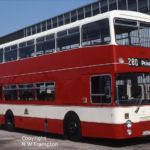
A280ROW (2)
An offside view of 280. The livery was probably the most successful aspect of this vehicle, as it was adopted for the rest of the fleet. 4 more Olympians with this style of bodywork came later, but with dual purpose seating. Unfortunately, most other Olympians bodied by East Lancs for other operators carried the rather plainer style of body as fitted to 278 and 279.
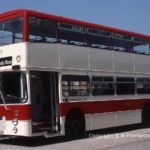
Dennis Dominator A277ROW at Portswood
In 1984 Southampton City Transport purchased 4 buses for uation as potential fleet standard vehicles, now that the Leyland Atlantean was no longer available. 277 was a Dennis Dominator with Maxwell gearbox, and the East Lancs body carried the standard fleet livery, but had some modern features by comparison with the traditional appearance of the large fleet of Atlanteans. The style was attractive, with a pleasantly raked front, but a couple of features spoiled the overall effect. The square corners of the upper deck front window jarred with the rounded corners of the other windows; while the upswept lower edge to the last window on the top deck looks odd - why do bodybuilders make windows at the back shallower, when that is almost always the darkest part of the bus? The Park Royal/Alexander style of driver's windscreen does not blend with the rest of the bodywork in the way that East Lancs' own version, as used on the Atlanteans, did - and the split level entrance - a compromise used on some vehicles prior to the development of true low floor buses - looks untidy.

Leyland Atlantean WOW529J at Portswood
Elderly Atlantean 139 was converted to a permanent open topper, principally for use on the City Tour, but also used on private hire work, and occasionally on normal service.
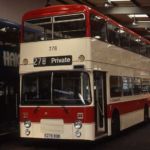
Leyland Olympian A278ROW at Portswood (1)
The four uation vehicles were all different, and 278 was a Leyland Olympian, again still in traditional livery. The bodywork is rather plainer than on 277, lacking the drooped window line on the upper deck towards the front, and having a generally more upright shape to the front.
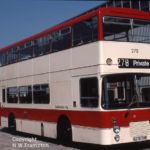
Leyland Olympian A278ROW at Portswood (2)
A front offside view of 278 at Portswood depot. 278 was the only one of the four experimental vehicles not fitted with a Gardner engine - it had a Leyland TL11 engine.
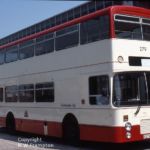
Leyland Olympian A279ROW at Portswood (2)
Another view of 279. The mismatch of the front windscreen to the rest of the bodywork can be clearly seen, as the windscreen narrows towards the top while the bodywork is vertical. The screen was clearly designed for single deckers! The positioning of the illuminated 'Pay as you enter' sign above the windscreen at the nearside looks untidy, and is probably too high for many people's line of vision, but passengers were probably used to the concept of OPO by 1984.

Leyland Olympian A280ROW at Portswood (1)
280 was the last of the four uation vehicles, again a Gardner-powered Olympian. This time, East Lancs used the attractive raked styling of the Dominator 277, with a conventional rubber mounted window at the upper deck front.
The livery experiment went further, being a direct reversal of the standard fleet livery, and the lower cream band even continued around the engine compartment panels.

Seddon RU BCR379K at Portswood
The 5 Seddon RUs delivered in 1972 were the last single deckers for over 15 years. Strangely, they were 33' long 44 seaters, with single doors, while the previous single deckers purchased were longer AEC Swifts with dual doors. After a fairly quiet life, 15 survived to be preserved, one of only two Seddon RUs remaining.
Noted for standardised fleets of Guy Arabs, and later Leyland Atlanteans – both reaching a total of 175 vehicles.